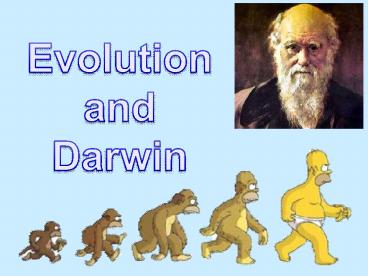Darwin and Evolution - PowerPoint PPT Presentation
Title:
Darwin and Evolution
Description:
Title: Darwin and Evolution Author: Robert & Marsha Goodman, Jr. Last modified by: Newark City Schools Created Date: 11/11/1997 5:20:44 AM Document presentation format – PowerPoint PPT presentation
Number of Views:371
Avg rating:3.0/5.0
Title: Darwin and Evolution
1
Evolutionand Darwin
2
Evolution
- The processes that have transformed life on earth
from its earliest forms to the vast diversity
that characterizes it today. - A change in the genes!!!!!!!!
3
- The one scientist who is most well known for
evolution is Charles Darwin - He did not reach this conclusion on his own
4
Ideas that helped shape Darwins thinking
- James Hutton Theory of geological change.
- He proposed that the earth is shaped by
geological forces that took place over extremely
long periods of time. He estimated the earth to
be millions of years old, not thousands (as
previously thought).
- This idea led Darwin to realize that if the earth
was millions of years old (not thousands), it
would mean there was enough time for organisms to
evolve.
5
Ideas that helped shape Darwins thinking
- Charles Lyell published Principles of Geology.
- Explained that the processes occurring now have
shaped earths geological features over long
periods of time. These processes are still - changing earth today.
- This idea led Darwin to
- realize that if the earth
- could change then so
- could life
6
Ideas that helped shape Darwins thinking
- Jean Baptiste Lamarck (early 1800s) proposed
- The inheritance of acquired characteristics
- He proposed that by using or not using its body
parts, an individual tends to develop certain
characteristics, which it passes on to its
offspring.
7
Ideas that helped shape Darwins thinking
- First scientist to propose a mechanism for how
organism change. - HE WAS WRONG!!!
8
Ideas that helped shape Darwins thinking
- Thomas Malthus Predicted that the human
population will grow faster than the space and
food supplies needed to sustain it. - This same prediction applies to organisms in
nature as well and leads to competition among them
9
Charles Darwin
- With this information in his mind Darwin set sail
on the H.M.S. Beagle (1831-1836) to survey the
south seas to collect plants and animals. - On the Galapagos Islands, Darwin observed species
that lived nowhere else in the world.
10
Charles Darwin
- Even though the islands are fairly close together
they have different environments. Varying from
lush jungle to bare volcanic land.
11
Charles Darwin
- In these different environments Darwin found
different types of animals - Finches were very different on each island
- Tortoises had very different necks on each island
12
Charles Darwin
- Charles Darwin is credited with the theory of
evolution, but scientists knew that organisms
change over time before Darwin..what Darwin
really came up with is the mechanism for change
(HOW organisms changed over time)
Darwins observations on the Galapagos and his
knowledge that things change over time led him to
write a book.
13
Charles Darwin
- Wrote in 1859 On the Origin of Species by Means
of Natural Selection - Two main points
- 1. Species were not created in their present
form, but evolved from ancestral species. - 2. Proposed a mechanism for evolution NATURAL
SELECTION
14
Natural Selection
- Individuals with favorable traits are more likely
to leave more offspring better suited for their
environment.
- Example Peppered moth
- Has both dark and light types
15
(No Transcript)
16
(No Transcript)
17
(No Transcript)
18
Natural Selection
- Overtime, natural selection results in changes in
the inherited characteristics of a population. - These changes increase a species fitness
(survival rate)
19
Natural Selection
- Natural selection is also sometimes called
survival of the fittest". In this case,
fittest does not necessarily mean fastest,
strongest, etc Fittest simply means the
organism has a trait that helps it survive and
reproduce (called an adaptation)
- If you are a turtle fittest might mean
strongest shell - If you are a chameleon fittest might mean best
camouflage
20
(No Transcript)
21
(No Transcript)
22
(No Transcript)
23
Artificial Selection
- The selective breeding of domesticated plants and
animals by man. - nature provides variation, humans select
variations that are useful. - Example - a farmer breeds only his best livestock
24
Evidence of Evolution
- 1. Fossil Record
- Fossils, and the order in which they appear in
layers of sedimentary rock, show the history of
life on earth and how different groups of
organisms have changed over time
25
Evidence of Evolution
- 2. Biogeography Geographical distribution of
species. Similar animals in different locations
were the product of different lines of descent
26
Evidence of Evolution
- 3. Homologous Structures Structures that are
similar because of common ancestry. - e.g. Wing of bat,
- human arm, leg of
- turtle
- Provides strong evidence that all four-limbed
animals have descended, with modifications, from
a common ancestor
27
Evidence of Evolution
- 3. Homologous Structures.
- Not all homologous structures serve important
functions. The organs of many animals are so
reduced in size that they are just vestiges, or
traces, of homologous organs in other species.
These vestigial organs are organs that serve no
useful purpose in an organism - e.g. pelvic bones in whales, appendix, wisdom
teeth and coccyx in humans
28
Evidence of Evolution
- 4. Comparative embryology
- In their early stages of development, chickens,
turtles and rats look similar, providing evidence
that they shared a common ancestry.
29
Evidence of Evolution
Evolution can be observed all around us..































